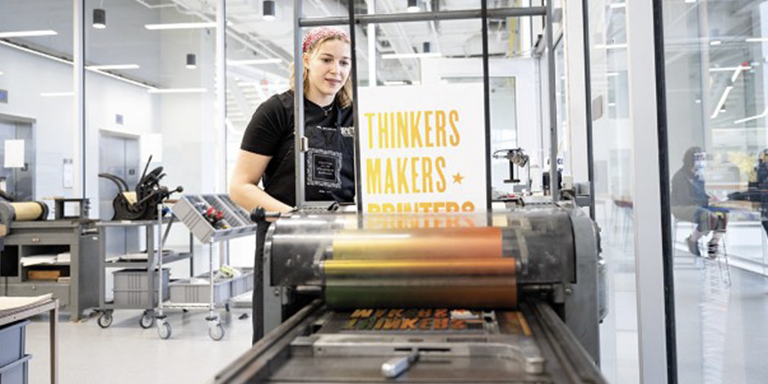RESOURCES
BLOG
Join in the community forum! The thINK blog is a place for community members to share their opinions, best practices, successes, and challenges. Add your comments to the blogs published here or write a blog and we’ll post it for you.

Letterpress Revival
Though it will never regain its prominent place in the printing world versus competitors like offset lithographic presses and production digital printing systems, letterpress printing is making a remarkable comeback. This comeback is not exclusively reserved for printing museums, though it is happening there too. New initiatives at colleges and universities are riding the letterpress wave. In addition, letterpress has strong support from many artists and designers who take advantage of the technology’s unique qualities.
What Can We Learn from Letterpress?
Writing on letterpress for the Daily Heller, author Steven Heller notes, “For a designer, learning to set metal and wood type is as essential as learning to drive a car…” In the same article, Dikko Faust, co-founder (with Esther K. Smith) of Purgatory Pie Press, praises letterpress because it is “dimensional, textural, direct-relief printing from modular pieces: letters, borders, and ornaments, as well as woodcuts, photo engravings (polymer plates), and found objects.” Faust, who offers a hands-on printing class at the SVA NYC Letterpress studio, states, “Letterpress is great research and development for any design problem. Change the color, change the paper (or cloth, sheet metal, thin wood, even plastic). Change the angle. Insert ornaments. Add words of different typefaces on the press bed. Add background textures, superimpose type for vibration/emphasis.”
This type of reasoning has inspired many colleges and universities to offer letterpress printing in one way or another.
Letterpress at the Rochester Institute of Technology
In a recent article entitled Maker Community Fills the New SHED, Susan Gawlowicz of the Rochester Institute of Technology (RIT) interviewed Leah Rosen, a fourth-year RIT student pursuing a dual degree in industrial design and psychology. Rosen says that the hands-on process of letterpress printing helps ground her and inspires her to think in an analog fashion in this digital era of ours. The Cary Pressroom for letterpress printing is one of seven “makerspaces” in RIT’s Student Hall for Exploration and Development (also known as SHED). Other SHED makerspaces are targeted at wood and metalworking, 3D printing, laser cutting, electronics, and textiles.
“There is such attention to detail and physicality to letterpress—or any hands-on making where there is a part of you in it,” Rosen said. “That’s what drew me to letterpress—it’s a deliberate and careful process. Then, there’s this beautiful intersection between design and this incredible technology that is hundreds of years old and combines with the written word.”

It is worth noting that RIT’s SHED offers more than 200,000 square feet of renovated and new construction on campus. It is the size of a city block and represents RIT’s largest capital project in 55 years… and letterpress is an important part of it!
Letterpress at Other Universities
Many universities offer letterpress as part of their curriculums. Here are a few examples:
- Huskiana Press: Huskiana Press at Northeastern University in Boston is an experiential letterpress studio for students, faculty, and community members. Founded in 2019, it serves as a joint project of Northeastern’s English and History departments. The equipment that the Huskiana Press uses was gathered and refurbished by volunteers at the Museum of Printing in Haverhill, Massachusetts.
- Skeuomorph Press & BookLab: Skeuomorph Press & BookLab at the University of Illinois Urbana-Champaign is an experiential studio for teaching and researching the history and art of the book. Housed in the Champaign-Urbana Community FabLab, it is sponsored by the School of Information Sciences, with support from the Department of English. Its director is Ryan Cordell, who founded the Huskiana Press at Northeastern.
- Tufts University Special Collections: A new letterpress initiative recently kicked off at Tufts University in Medford, Massachusetts (near Boston). Part of Tufts’ Tisch Library Special Collections, the use of letterpress highlights the university’s kinship with rare texts in its collection going back to the 15th Century. Special Collections Director Chris Barbour notes that composing type for letterpress printing offers insights into how books were made over the centuries and that process can inspire students through experiential learning. Barbour quoted woodworker Doug Stowe: “Without the opportunity to learn through the hands, the world remains abstract, and distant, and the passions for learning will not be engaged.”

The Bottom Line
The collegiate programs described here only just scratch the surface of the letterpress revival. If you look around, you’ll see young artists and designers taking advantage of an old and proven technology. Quite a few of these initiatives gain support in one fashion or another from institutions like the Hamilton Wood Type & Printing Museum (Two Rivers, Wisconsin), Hatch Show Print (Nashville, Tennessee), the International Printing Museum (Carson, California), and the Museum of Printing (Haverhill, Massachusetts). All of these sites are working to keep the craft of analog printing alive and vital.
Author bio: Jim Hamilton of Green Harbor Publications (www.greenharbor.com) is an industry analyst, market researcher, writer, and public speaker. For many years he was Group Director in charge of InfoTrends’ Production Digital Printing & Publishing consulting services. He has a BA in German from Amherst College and a Master’s in Printing Technology from the Rochester Institute of Technology.
